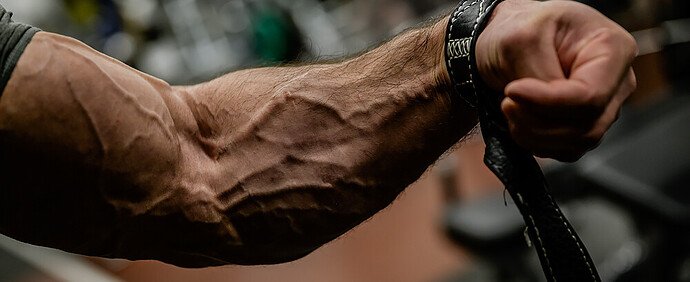Forearm Exercises You Need
With the right training, you can build big forearms quickly. So there’s no reason for yours to be stuck at average. Here’s what to do.
Build Big Forearms
Everyone knows to train their largest muscle groups to look strong and powerful. To speed up the process of developing the coveted “power look,” you should also train a few smaller muscle groups. This can quickly make a dramatic visual impact.
Along with the traps and neck, high-frequency forearm training can significantly affect how you look.
Forearms Are Fundamental
Forearms Are Fundamental
Big, muscular forearms are associated with strength and physical work. They’re also a more visible body part, which gives people an instant clue about the rest of your physique.
Vascular and defined forearms automatically give the impression of a lean physique. That muscularity immediately makes you think that the person is strong. A massive set of forearms also signals that you’re a hard worker because most people with thick forearms are either manual laborers or strong lifters.
By the way, that’s why politicians will often roll up their sleeves when giving speeches: showing their forearms creates the subconscious impression that they’re hard workers, trustworthy, and even blue-collar. Most of the time, this is false. (And do any of them have forearms worth showing?)
From a performance standpoint, strong forearms and grip will give you a massive leg up. They’ll make your lifts more stable and efficient and allow you to use more weight to stimulate the target muscle(s) better.
The benefits are huge: being able to deadlift, clean, or snatch big weights, not letting an opponent go when you tackle him, and even hitting a ball harder. The bottom line? Massive forearms, and the grip that comes with them, are a must for serious lifters.
High-Frequency Forearm Training
High-Frequency Forearm Training
You’ll make fast progress using high-frequency training. The forearms will respond well to it, unlike your larger muscle groups which need more time for recovery. Also, the best exercises for smaller muscle groups cause very little muscle trauma.
The more frequently you can train a recovered muscle, the faster you’ll make progress. But each workout’s stimulus must be sufficient to make the muscles grow.
Sure, you can still progress with a lower frequency, but you can train forearms and grip pretty much daily, especially if you train different functions each day. So let’s get into it.
The 8 Forearm Functions
The 8 Forearm Functions
To maximize your forearms, you must train as many functions as possible. The forearms include twenty different muscles (the hand and wrist have even more), so they’re complex and have a bunch of different functions:
- Wrist Flexion
- Wrist Extension
- Wrist Radial Deviation/Abduction
- Wrist Ulnar Deviation/Adduction
- Supination
- Pronation
- Wrist Rotation
- Grip (Crushing and Holding)
Forearm training also helps prevent wrist, elbow, and shoulder injuries. However, overdeveloping certain forearm muscles over the others could have the opposite effect and increase the risk. Most people tend to prioritize wrist flexion and extension. This leaves out several functions/muscles and leads to imbalances.
Those who don’t do direct forearm work tend to overdevelop wrist flexion and its involved muscles. These are the muscles you incidentally train when doing curls and rows/pulls.
That’s why we don’t need to train wrist flexion directly; you’re already doing it with the rest of your training. So the main functions we DO need to work on directly are wrist extension, ulnar deviation, radial deviation, supination, and pronation.
Let’s look at the exercises that I use and recommend.
Note: Curls (wrist flexors), reverse curls (wrist extensors), and hammer curls (wrist abduction muscles) do train the forearms, but let’s look at the more isolated exercises.
The Exercises
The Exercises
1. WRIST EXTENSION (CABLE OR DUMBBELLS)
- Function Trained: Wrist extension
- Recommendations: Do 3-4 sets of 10-15 reps. I like to use the pre-fatigue approach of holding the peak contraction for 15-20 seconds and then doing 8-12 reps.
2. WRIST ROLLER
- Functions Trained: Wrist extension, wrist flexion
- Recommendations: Do 3-4 sets of 10-20 twists.
3. THOR’S HAMMER
- Functions Trained: Supination, pronation
- Recommendations: Do 3-4 sets of 10-15 full reps on each side.
4. LEVERAGE LIFT OR HOLD
- Functions Trained: Radial/abduction
- Recommendations: Do 3-4 sets of 10-15 reps or isometric hold for 30-45 seconds.
5. LYING ADDUCTION
- Functions Trained: Ulnar deviation/adduction
- Recommendations: Do 3-4 sets of 10-15 reps.
6. POWERBALL WRIST ROTATIONS
Note: You can pick up one of these gadgets here.
- Functions Trained: Flexion, extension, adduction, abduction
- Recommendations: Do 3-4 sets for as long as possible.
7. GRIPPER (FOR REPS OR TIME)
- Function Trained: Finger flexion (crushing)
- Recommendations: Do 3-4 sets of 6-8 reps, or hold for 9-12 seconds.
8. THICK BAR HOLD
- Function Trained: Finger flexion (holding)
- Recommendations: Do 3-4 sets of 30-60 seconds.
Training Guidelines
Training Guidelines
You can train your forearms and grip up to 5-6 times weekly. Try one or two forearm or grip exercises in every workout.
If you want to see how I’m training, check out my Training Log. Or, ask me anything in my free Coaching Lab.
T Nation earns from qualifying purchases as an Amazon Associate. Read more about our policy.



